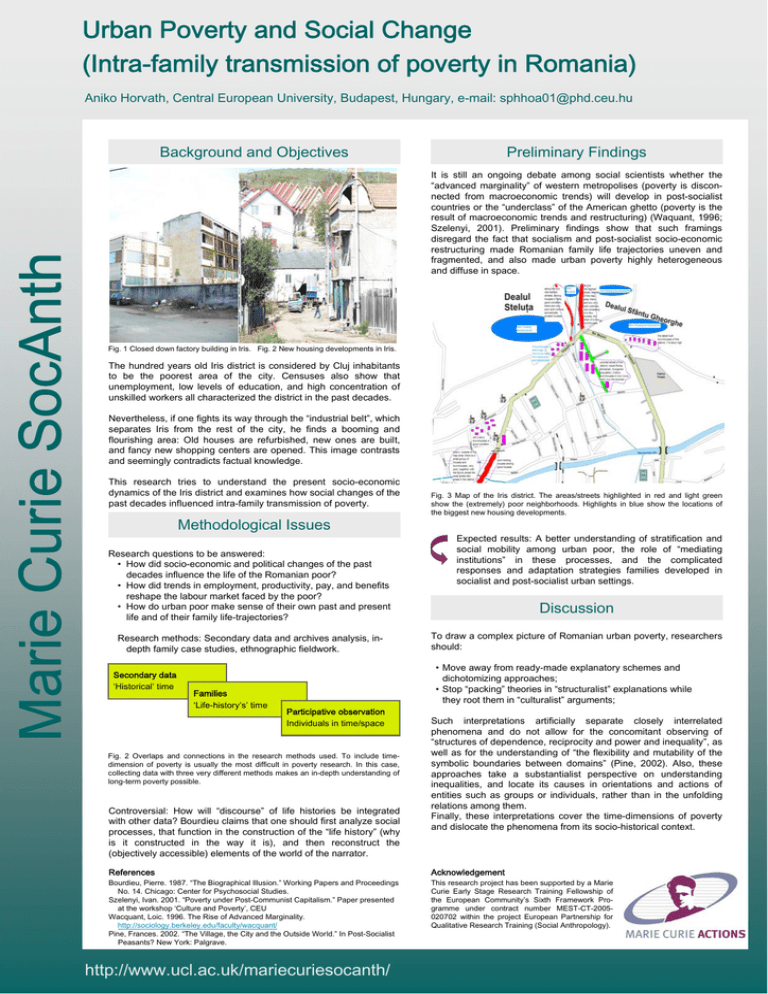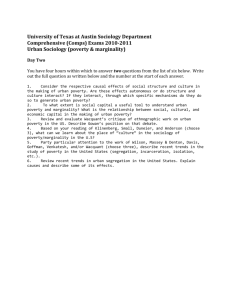Urban Poverty and Social Change (Intra-family transmission of poverty in Romania)
advertisement

Urban Poverty and Social Change (Intra-family transmission of poverty in Romania) Aniko Horvath, Central European University, Budapest, Hungary, e-mail: sphhoa01@phd.ceu.hu Background and Objectives Preliminary Findings It is still an ongoing debate among social scientists whether the “advanced marginality” of western metropolises (poverty is disconnected from macroeconomic trends) will develop in post-socialist countries or the “underclass” of the American ghetto (poverty is the result of macroeconomic trends and restructuring) (Waquant, 1996; Szelenyi, 2001). Preliminary findings show that such framings disregard the fact that socialism and post-socialist socio-economic restructuring made Romanian family life trajectories uneven and fragmented, and also made urban poverty highly heterogeneous and diffuse in space. Fig. 1 Closed down factory building in Iris. Fig. 2 New housing developments in Iris. The hundred years old Iris district is considered by Cluj inhabitants to be the poorest area of the city. Censuses also show that unemployment, low levels of education, and high concentration of unskilled workers all characterized the district in the past decades. Nevertheless, if one fights its way through the “industrial belt”, which separates Iris from the rest of the city, he finds a booming and flourishing area: Old houses are refurbished, new ones are built, and fancy new shopping centers are opened. This image contrasts and seemingly contradicts factual knowledge. This research tries to understand the present socio-economic dynamics of the Iris district and examines how social changes of the past decades influenced intra-family transmission of poverty. Methodological Issues Research questions to be answered: • How did socio-economic and political changes of the past decades influence the life of the Romanian poor? • How did trends in employment, productivity, pay, and benefits reshape the labour market faced by the poor? • How do urban poor make sense of their own past and present life and of their family life-trajectories? Research methods: Secondary data and archives analysis, indepth family case studies, ethnographic fieldwork. Secondary data ‘Historical’ time Families ‘Life-history’s’ time Fig. 3 Map of the Iris district. The areas/streets highlighted in red and light green show the (extremely) poor neighborhoods. Highlights in blue show the locations of the biggest new housing developments. Expected results: A better understanding of stratification and social mobility among urban poor, the role of “mediating institutions” in these processes, and the complicated responses and adaptation strategies families developed in socialist and post-socialist urban settings. Discussion To draw a complex picture of Romanian urban poverty, researchers should: • Move away from ready-made explanatory schemes and dichotomizing approaches; • Stop “packing” theories in “structuralist” explanations while they root them in “culturalist” arguments; Participative observation Individuals in time/space Fig. 2 Overlaps and connections in the research methods used. To include timedimension of poverty is usually the most difficult in poverty research. In this case, collecting data with three very different methods makes an in-depth understanding of long-term poverty possible. Controversial: How will “discourse” of life histories be integrated with other data? Bourdieu claims that one should first analyze social processes, that function in the construction of the “life history” (why is it constructed in the way it is), and then reconstruct the (objectively accessible) elements of the world of the narrator. Such interpretations artificially separate closely interrelated phenomena and do not allow for the concomitant observing of “structures of dependence, reciprocity and power and inequality”, as well as for the understanding of “the flexibility and mutability of the symbolic boundaries between domains” (Pine, 2002). Also, these approaches take a substantialist perspective on understanding inequalities, and locate its causes in orientations and actions of entities such as groups or individuals, rather than in the unfolding relations among them. Finally, these interpretations cover the time-dimensions of poverty and dislocate the phenomena from its socio-historical context. References Acknowledgement Bourdieu, Pierre. 1987. “The Biographical Illusion.” Working Papers and Proceedings No. 14. Chicago: Center for Psychosocial Studies. Szelenyi, Ivan. 2001. “Poverty under Post-Communist Capitalism.” Paper presented at the workshop ‘Culture and Poverty’, CEU Wacquant, Loic. 1996. The Rise of Advanced Marginality. http://sociology.berkeley.edu/faculty/wacquant/ Pine, Frances. 2002. “The Village, the City and the Outside World.” In Post-Socialist Peasants? New York: Palgrave. This research project has been supported by a Marie Curie Early Stage Research Training Fellowship of the European Community’s Sixth Framework Programme under contract number MEST-CT-2005020702 within the project European Partnership for Qualitative Research Training (Social Anthropology). http://www.ucl.ac.uk/mariecuriesocanth/






